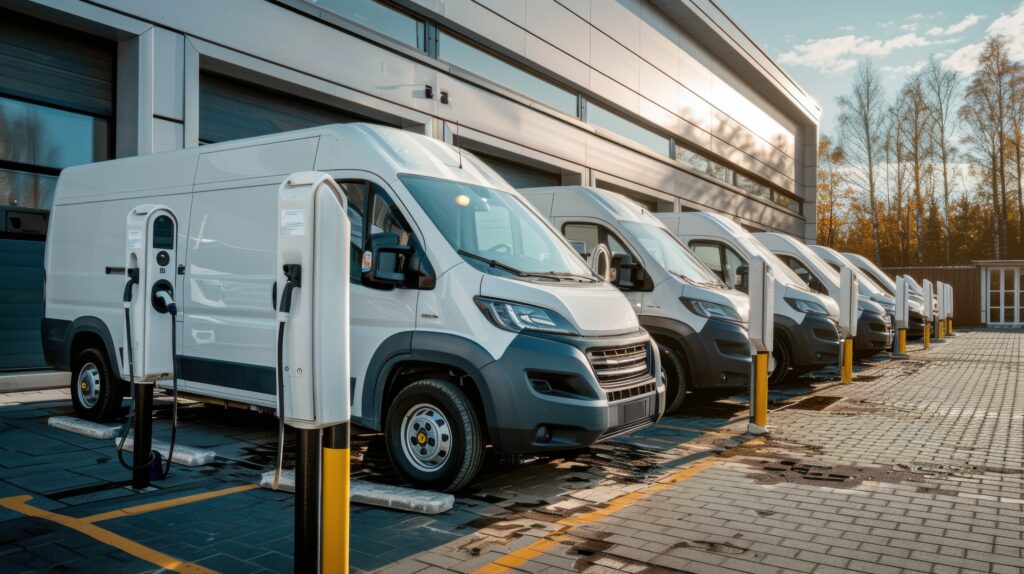

As electric vehicle (EV) adoption accelerates in fleets across the nation, one of the biggest challenges facing fleet managers is the development of reliable and scalable charging infrastructure. As electric assets become more commonplace, and heavy duty technologies begin to hit the road, local infrastructure may struggle to keep up with rising energy demand. Effective planning, strategic partnerships, and data-driven solutions are key to overcoming these hurdles and ensuring the smooth integration of EVs into fleet operations.
Data collection is a crucial step towards effective planning and decision-making in electrified fleets. Smart chargers have emerged as a preferred choice for EV charging, due to their ability to track data, manage load, and integrate with fleet management systems. In fact, it is becoming more and more difficult to find charging technologies in today’s marketplace that do not offer smart integrations. While legacy “dumb chargers” still serve basic needs, they lack the advanced features needed to support long-term EV growth, such as data tracking for clean fuel credit reporting or energy cost analysis.
Alternatively, many fleets are finding that telematics devices can circumvent the need for smart charger management, and simplify the scenario on the ground by offering a one-size-fits-all solution. Telemetry data is capable of assessing energy demand, while simultaneously offering utilization data in the same ecosystem that can help streamline well-informed decision-making. Aligning charging and utilization will allow fleets to effectively power their electric assets and relieve stress on the local grid without compromising fleet efficacy, by distributing electric load in accordance with usage patterns and vehicle needs. As fleets ramp up their electrification efforts, the importance of these nascent datasets to effective fleet operations becomes clearer by the day.
Determining the number and type of chargers required to service an electric fleet is a complex process that relies on data analysis and strategic forecasting. Fleet managers must be able to evaluate driving patterns, vehicle dwell times, and energy consumption, ensuring that existing and future infrastructure aligns with actual use patterns. For example, properly assessing vehicle energy requirements while considering charging speed and utilization patterns, allows for strategic adoption of fast-charging solutions in targeted high-traffic areas.
Future-proofing is essential as EV technology and fleet requirements evolve. Forward-thinking fleet managers are investing in scalable infrastructure by installing oversized conduits that can support future fleet upgrades, especially when heavy-duty electric vehicles hit the marketplace. Aligning charging infrastructure rollouts to precede vehicle acquisition plans is another way to ensure readiness upon EV deployment. Proactive scaling of charging infrastructure will be a critical component of effective fleet electrification.
Installing permanent charging infrastructure isn’t always feasible in the short term – such implementations can run into logistical and administrative nightmares that push projects out many weeks, or even months. Temporary charging solutions can allow for more agile electric vehicle implementations, while permanent infrastructure is being developed. Solar-powered charging units are an example of an off-grid option, particularly useful for remote locations or emergency scenarios. These systems offer flexibility and energy resilience, but come with higher upfront costs, so they’re best suited for specific use cases where grid connectivity is limited.
Mobile charging units can be deployed to service fleets at work sites where infrastructure buildout is not feasible, eliminating the need for critical assets to return to depots between shifts. These units can be used to prop up temporary energy hubs in charging deserts, and can be critical strategic elements of permanent fleet operations after temporary infrastructure needs are met.
Another practical approach is leveraging the chargers sometimes provided by vehicle manufacturers as part of a vehicle purchase package. These chargers can support temporary installations in locations where permanent infrastructure is not yet readily available or desirable in the long term. For instance, chargers bundled with new EVs can be deployed at substations or temporary locations, allowing drivers to “top off” until permanent installations are complete.
Whatever technologies fleets may use to accomplish their electrification goals, utilities will play a critical role in properly scaling charging infrastructure. Collaboration between organizations and their local utilities early in the planning process ensures that power requirements and infrastructure upgrades align with fleet needs. Fleet managers are increasingly pushing for future-proof solutions, to minimize disruptions to their electrification plans. Some of these processes, such as installing larger conduits and preparing sites for higher-capacity chargers, encounter feasibility challenges like lengthy lead times for transformers and restrictive capacity allocations. These hurdles can complicate project plans, and timely communication with local utilities can help ensure smooth implementations.
Many utilities may offer EV-focused programs, and can be invaluable allies in the electrification process offering fleet analyses, load assessments, and tailored infrastructure solutions. In areas where utilities are less cooperative, advocating for EV-friendly policies and being an active participant in infrastructure planning can have a positive influence on future outcomes. Other partnerships with telematics providers, Clean Cities coalitions, and technology vendors can significantly enhance fleet electrification efforts, by helping to identify opportunities well-suited for electrification or providing access to grants and incentives that ease the financial burden of electrification.
The transition to electric fleets requires thoughtful planning and proactive problem-solving. By leveraging temporary solutions, engaging utility partners, prioritizing smart charging infrastructure, and planning for future needs, fleet managers can navigate the challenges of scaling EV infrastructure. Data driven decision-making will lead to a more sustainable fleet and allow forward-thinking organizations to benefit from long-term cost savings and operational efficiency. Electrification is no longer a question of “if” but “how”. By adopting these strategies, fleet managers can drive their organizations toward a cleaner, more efficient future.

Privacy Policy | Data Agreement
Electric Vehicle Consortium is powered by Utilimarc, LLC. Copyright 2024, All Rights Reserved. Utilimarc is a Registered Trademark.